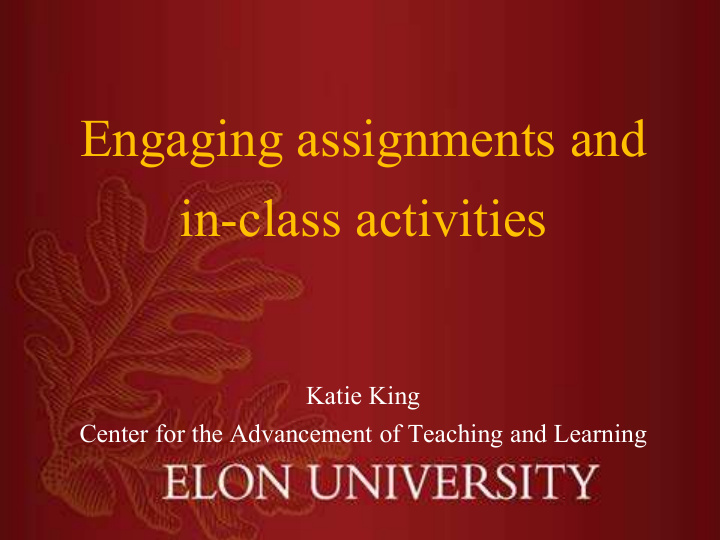



Engaging assignments and in-class activities Katie King Center for the Advancement of Teaching and Learning 1
Plan for this session Time Participant structure Activity 10:00 Whole Group Overview 10:20 Work Teams Jigsaw assignments 10:40 Home Teams Share ideas 11:00 Whole Group Wrap up 2
Engaged learning is a pleonasm Deep conceptual learning does not happen without engagement - a state of motivated, focused mental (and sometimes physical) activity Engaged learning occurs as a solo activity or in dialogue with others (face-to-face or mediated) Engaged learning is creative & constructive 3
Engaged learning at Elon Organize content around enduring concepts & big questions that have immediate significance outside the context of the course Focus on content and process; model & guide processes, especially those specific to your discipline Require students to be responsible for their learning : preparing, bringing in content, & making links to prior knowledge Prompt integrative critical reflection e.g., on relationships between: theory application , course community, concrete experiences abstract concepts this learning activity other experiences/courses 4
Sequence in- & out-of-class activities How will students use what they learn out of class when they are in class --- and vice versa? Fink’s Castletop (2005) -- Weave activities across contexts so learning is integrated & cumulative 5
Designing for deep learning Activities are constructive, interlinked, & sequential, requiring progressively more complex thinking: Analysis – what are the important dimensions along which this concept varies? How are the parts related to the whole? Elaboration –where does this fit into a rich conceptual database? What else can it be connected to? Synthesis – across a variety of sources, integrating new material with prior knowledge, including student voice Application – using newly integrated concepts to interpret familiar situations and then to make inferences about new 6 situations and solve novel problems
Double entry journals/blogs Students complete double entry journals as they encounter new information (making text-self, text-text, and text-world connections) then share with some audience, e.g., pair-share in class What? So what? Q: Exact quote p # Is this a simile? Summary or main point I would argue… Interesting or confusing idea So, does that mean that…? 7
Just in Time Teaching Use student responses to warm-up assignments to structure in-class activity (Novak, 2011, p. 66) 8
More examples of integrative activities Students locate and post relevant sources related to reading, these are used to initiate discussion in class Students prepare and lead part/all of class activity or discussion Students take turns summarizing class discussion & post after class Students write in pairs to a prompt or vignette in-class as a bridge between reading, class coverage, and individual writing Others? 9
Thinking outside the box turtle 1. Students in Josh Kapfer’s Wildlife Ecology (WE) course used GPS equipment to collect wildlife movement and habitat data 2. The raw data was sent to students in Ryan Kirk’s Geographic Informational Systems (GIS) course 3. GIS students analyzed components of this information (e.g., land cover and spatial pattern estimation) with GIS software 4. WE students interpreted the data and wrote up reports 10
Jigsaw Jigsaw 1. Participants start out in home teams to tackle a problem; 2. move to work teams to specialize in a specific aspect of the problem; then 3. come back to home teams to share what they have learned. 11
Wrap up Any ‘ah ha!’ moments? What do you want to find out more about? How will you use these ideas in your own teaching? 12
References Ambrose, S. A., et al. (2010). How learning works: 7 research based principles for smart teaching. Barkley, E. F. (2010). Student engagement techniques . Fink, D. (2005). Integrated course design The Jigsaw Classroom http://www.jigsaw.org/links.htm Novak, G. (2011). Just in time teaching. New Directions in Teaching and Learning, 128 , 63-73. Simkins, S., & Maier, M. (2010) Just in time teaching: Across the disciplines, across the academy Swaner, L. E. (2012). The theories, contexts, and multiple 13 pedagogies of engaged learning: What succeeds and why?
Recommend
More recommend